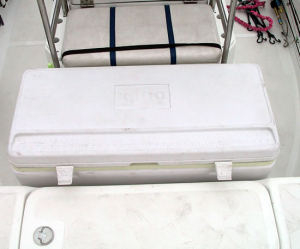And the Winner Is…

Toy Boat 2 – an Edgewater 175CC
Have you ever had the feeling that something was meant to happen?
After looking around for more than a year, I was getting frustrated. I was constantly finding likely boats that turned out to be just a bit too long or tall or wide, or couldn’t use my existing motor.
I had spoken to Boat Depot in San Diego (now defunct) several times previously, as they were also Ranger, Bayrunner and Crestliner dealers. The salesmen at Boat Depot kept telling me to come in to take a look at an Edgewater, but never having heard of the company, I kept putting them off. I finally got around to making the drive down, and as I walked into their showroom, the EW 175 immediately caught my eye.
After checking out so many hulls, I thought I could tell by looking whether or not a boat was going to be about the right size. But the EW 175 fooled me. It looked larger.

Igloo ice chest acting as a fish box or storage compartment
It was sitting on a trailer already rigged with an Evinrude 115 Ficht, which was identical in size and weight to my 90 HP Johnson. I pulled out my measuring tape, and measured from the back of the motor to the tip of the high bow rail – 19′ 2″. From the ground to the top of the console handrail, it measured 6′ 11″, and its width on the trailer – 7′ 10″. Things were looking good! I hopped inside and looked around.
First negative – no recessed rod racks, but I thought I could live with that. Second negative – the boat did not have a lot of protected storage. There was a nice front casting deck, but the compartment under it looked just large enough for ground tackle and miscellaneous boat stuff like fenders. The storage area under the seat in the front of the console (actually intended by Edgewater to act as a livewell) looked to be large enough to hold emergency gear, but not much more.
The console itself was fairly large for a boat this size, but because Edgewaters are foam-filled hulls, batteries and the engine oil reservoir would have to fit inside. There were no built-in fish-boxes or ice chests, and no under-deck compartments other than the front casting platform.

Port and starboard ice chests as storage compartments and seats.
But I thought I could work around the storage problems. In boats I had owned previously, I used plastic coolers to add storage. I could do the same here, if I could find the right size ice chests.
For example, the front casting deck stopped short of the console front seat. I taped out the gap, and determined that the space was big enough to accept my 120 quart Igloo® cooler. I could use that cooler as a fishbox. On the port and starboard corners of the stern I could mount coolers as seats, and use them for more storage. If I changed my current tackle bags to some waterproof bags, I could leave them on-deck.
The final selling point was that Boat Depot was “throwing in” a livewell as part of the purchase price. I was anticipating one of the smaller translucent polyethylene tanks, like a Kodiak. Instead, they were going to install an Offshore Products (now Bluewater Bait Systems) fiberglass tank, which is a really nice, higher-end brand. They didn’t blink an eye when I asked for the 42 gallon oval leaning post tank.
And to top it off, they were more than happy to remove the Evinrude Ficht and mount my engine on the hull. Since it was already rigged for an OMC engine, all I needed to purchase was an adapter kit to connect the newer electronics and controls to my vintage 1991 motor. Sold!
The Final Results…
Here are the basic stats on Toy Boat 2, along with the 2nd, third and fourth-place hulls for comparison. As you can see, they are all really close:
| Stats | Edgewater 175 CC | Western Eagle 180 | Pacific Skiff V1725 | Hydrasports 180 Seahorse |
| LOA | 17′ 6″ | 18′ | 17′ 3″ | 17′ 7″ |
| Beam | 7′ 4″ | 7′ 6″ | 7′ 1″ | 8′ 1″ |
| Fuel capacity | 45 gallons | 30 gallons | 32 gallons | 58 gallons |
| Dry weight | 1,500 lbs | 950 lbs | 1,110 lbs | 2,120 lbs |
| Draft | 10″ | 12″ | Data not available | 14″ |
| Weight capacity | 1,300 lbs | 1,600 lbs | 1,750 lbs | 1,000 lbs |
| People capacity | 7 | 7 | Data not available | 5 |
| Maximum HP | 130 | 150 | 115 | 150 |
Next up: Toy Boat 2 at first launch

